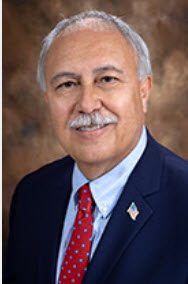Although not yet a formal agenda item and there was no immediate suggestion about closing campuses, merely raising the shutter issue in the context of underutilization of space and programs triggered a lightening reaction from Third District Representative Paul Chevalier

Third District Representative Paul Chevalier
While discussing Community College underutilization of programs and the efficient use of space at the March 22 Governing Board meeting, Fifth District west-side representative Mitch Padilla reminded the Board that “we can consolidate. We can shutter a campus and reallocate dollars that would go to something that is simply not being utilized.”
He said he wasn’t calling for shuttering of campuses or anything like that although he has “personal opinions” on that. He said, however, that if the College is “spinning its wheels on maintenance and under-utilization on a program” that is not being used but is the primary function of a particular campus, “I don’t have problem shuttering it and using funds elsewhere.” (See video clip below.)
So, although not saying it directly, was he thinking about the Culinary Institute and the Sedona Center?

Fifth District Representative Mitch Padilla
The comments immediately triggered a reaction from Third District Representative Paul Chevalier and the last time the Board considered shuttering the Sedona Center and the Chino Valley Center. He immediately responded and was adamant in his defense of keeping the Sedona Center and the Clarkdale Campus on the east side of Mingus Mountain from being shuttered. (See video tape clip). He commented that even the suggestion of closing campuses on the east side of Mingus Mountain would “cause a revolution over here.”
District one representative Ray Sigafoos, who voted in December 2013 for the Board to consider closing the Sedona Center and the Chino Valley Center, said he didn’t hear a “single word” about closing a campus or closing Clarkdale. Sigafoos speculated that as an example maybe the Board might look at the Chino Valley Center or Learning Centers at some time in the future. (See video clip below.)
Community College Vice President Clint Ewell closed out the conversation by saying the College has too much space and it needs to look at how it can better utilize that space. (See video clip below.)
The Board attorney cut off further discussion noting the issue was not on the agenda.
A video clip of a portion of the conversation among Board members on this issue appears below. You will be able to view a video of the entire Board meeting several weeks in the future when the video is included with the Governing Board minutes of the meeting.


 The original $103.5 million capital development plan is now at $76 million. This is a savings of $27.5 million, all of which resulted from changing construction at the Prescott Valley Center. There was an additional $3 or more million saved but that money was reallocated to the Sedona Center.
The original $103.5 million capital development plan is now at $76 million. This is a savings of $27.5 million, all of which resulted from changing construction at the Prescott Valley Center. There was an additional $3 or more million saved but that money was reallocated to the Sedona Center. Originally, the College intended to build a 136,000 square-foot building at a cost of $52 million at the Prescott Valley Center. That was to house an expanded Allied health program, possibly in a partnership with northern Arizona University. The College says it will now build a 9,000 square foot addition at a cost of about $5.8 million at the Center and cap the cost of a future university learning Center at $14 million.
Originally, the College intended to build a 136,000 square-foot building at a cost of $52 million at the Prescott Valley Center. That was to house an expanded Allied health program, possibly in a partnership with northern Arizona University. The College says it will now build a 9,000 square foot addition at a cost of about $5.8 million at the Center and cap the cost of a future university learning Center at $14 million. The efforts by the Verde Valley Board Advisory Committee and the two Verde Valley representatives on the Governing Board to slow down and require the administration to justify these multi-million dollar projects have been for naught. Wills’ has never had her hands on so much tax money she can spend without interference from the Board.
The efforts by the Verde Valley Board Advisory Committee and the two Verde Valley representatives on the Governing Board to slow down and require the administration to justify these multi-million dollar projects have been for naught. Wills’ has never had her hands on so much tax money she can spend without interference from the Board.
